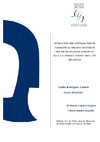Identificador persistente para citar o vincular este elemento:
https://accedacris.ulpgc.es/jspui/handle/10553/12316
| Campo DC | Valor | idioma |
|---|---|---|
| dc.contributor.advisor | Gelado Caballero, María Dolores | - |
| dc.contributor.advisor | Sánchez González, Alberto | - |
| dc.contributor.author | Rodríguez Amador, Galileo | - |
| dc.date.accessioned | 2014-10-14T02:30:08Z | - |
| dc.date.accessioned | 2018-06-04T14:13:29Z | - |
| dc.date.available | 2014-10-14T02:30:08Z | - |
| dc.date.available | 2018-06-04T14:13:29Z | - |
| dc.date.issued | 2014 | en_US |
| dc.identifier.uri | https://accedacris.ulpgc.es/handle/10553/12316 | - |
| dc.description.abstract | The organic matter in the water column and sediment in transitional and marine environments in the ocean is described by a binary mixture of marine and terrestrial sources. The C:N ratio and δ13C of samples and sources is used in a linear equation to estimate the fraction of organic matter (OM) from land in aquatic and sedimentary environments. However, terrestrial OM is relatively depleted in N and this fraction has been seriously and systematically underestimated by this misinterpretation of the C:N ratio and δ13C. Additionally, the composition of the Earth's organic matter is not well known in the region of Magdalena, as is the case in many studies in arid areas with little or no input from rivers. In this work new data for reason N:C and δ13C core are shown severity collected at 700 m depth in order to evaluate the contribution of different sources of OM in the south-western Baja California margin, characterized by extensive oxygen minimum zone and high primary productivity. The N:C ratio suggests that the contribution of various land-based MO of between 19 and 57% during the late Holocene. The binary mixture the N:C ratio and δ13C of OM appears indicate that marine source remains the dominant source. | en_US |
| dc.format | application/pdf | es |
| dc.language | eng | en_US |
| dc.rights | by-nc-nd | es |
| dc.subject | 251002 Oceanografía química | en_US |
| dc.subject.other | Sediment | es |
| dc.subject.other | N:C ratio | es |
| dc.subject.other | δ13C | es |
| dc.subject.other | Organic Matter | es |
| dc.subject.other | OMZ | es |
| dc.subject.other | Holocene | es |
| dc.title | Estimating the contribution of terrestrial organic matter in the South-Western margin of Baja California during the late Holocene | en_US |
| dc.type | info:eu-repo/semantics/bachelorThesis | en_US |
| dc.type | BachelorThesis | en_US |
| dc.compliance.driver | 1 | es |
| dc.contributor.departamento | Química | en_US |
| dc.contributor.facultad | Facultad de Ciencias del Mar | en_US |
| dc.identifier.absysnet | 702217 | es |
| dc.investigacion | Ciencias | en_US |
| dc.rights.accessrights | info:eu-repo/semantics/openAccess | es |
| dc.type2 | Trabajo final de grado | en_US |
| dc.utils.revision | Sí | en_US |
| dc.identifier.matricula | TFT-29560 | es |
| dc.identifier.ulpgc | Sí | en_US |
| dc.contributor.buulpgc | BU-BAS | en_US |
| dc.contributor.titulacion | Grado en Ciencias del Mar | es |
| item.fulltext | Con texto completo | - |
| item.grantfulltext | open | - |
| crisitem.advisor.dept | GIR Tecnologías, Gestión y Biogeoquímica Ambiental | - |
| crisitem.advisor.dept | Departamento de Química | - |
| Colección: | Trabajo final de grado | |
Visitas
205
actualizado el 15-ene-2026
Descargas
120
actualizado el 15-ene-2026
Google ScholarTM
Verifica
Comparte
Exporta metadatos
Los elementos en ULPGC accedaCRIS están protegidos por derechos de autor con todos los derechos reservados, a menos que se indique lo contrario.
